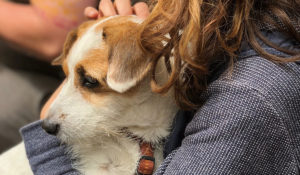
“One of the hardest things that many dogs have to endure is “”goodbye.”” While we owners know that walking out the door and going to work doesn’t mean we’re gone forever, dogs aren’t always capable of grasping the concept.
To many of them, when you walk out the door, you may be gone forever. This is what is known as “”separation anxiety.””
There are many levels of this condition. Some result in destructive behavior, while others reflect a dog’s feelings through pacifistic or self-neglecting characteristics.
As a dog owner, it is important that you pay attention to not only what your dog does when you’re around, but also to what they’re doing when you’re not around.
A little restless
The most common symptom of separation anxiety is a dog’s destructive behavior.
This can target many areas of your home and life. From chewed clothing to damaged doorways, a dog finds ways to cope with their anxiety. Consider yourself when you’re anxious.
The mind is worried, but the body is energized. You want to get up and do something. Dogs seldom have ways of coping with these feelings of anxiety in a positive manner.
So, they often turn to targeting items in the household that remind them of you. They aren’t just being recklessly destructive-they’re usually looking for things that smell like you.
Chewing on the remote control or a favorite pair of shoes is a favorite of anxious dogs. They aren’t purposely destroying the item, just favoring it because it reminds them of you.
Another characteristic of anxiety is the scratched doorway.
Some dogs will scratch to be let out when they want to go out, but an anxious dog may wait at the door throughout the day, clawing at it because they believe they can get back to you if they can only get through that door.
Remember that a dog doesn’t always realize where you are when they can’t see you. Doors are simply obstacles, blocking their view of a loved one.
Sad to say goodbye
When suffering from separation anxiety, dogs may also exhibit signs of depression, often waiting by the door and neglecting eating, drinking, or even potty cycles.
This can be difficult to detect, especially since the side effects, such as depreciating health, can be slow to come. Health may deteriorate over time, especially since they’ll return to their regular habits once you’ve returned home.
Any form of anxiety has detrimental effects on a dog’s health. Whether it’s depression or elevated activities, the stress from the situation wears on the heart and body, which can result in an unhealthy and ultimately unhappy lifestyle.
Say goodbye to anxiety
Separation anxiety isn’t an easy condition to deal with. It is more psychological than physical, making it difficult to diagnose and treat medically.
But, as a dog owner and lover, it is up to you to make your dog realize that goodbye is just temporary.
There are many remedies that help anxious dogs. Calming biscuits and even prescription medication can help with less severe cases.
These remedies are designed to help a dog relax during the day while you’re gone, so that they aren’t as destructive to your home and their health. The problem with these remedies, however, is that they don’t actually cure the problem.
What is necessary is to teach your beloved dog that you are only gone for now, but you’ll always return to them.
The best place to start is a little confusion. Dogs love and rely on a schedule. They wake up, eat, potty, and sleep at a regular time every day. So, you don’t want their anxiety to be included in that schedule.
That means you must let them know that when you’re gone, the day goes on. Start with the characteristics that are associated with you leaving.
The jingle of your keys, putting your coat on, or even making your morning smoothie can tell your dog: I’m getting ready to leave. Rather than actually leaving when you do these things, practice them intermittently throughout the day.
Once your dog has become accustomed to these practices, move on to leaving periods. At first, leave for only a few minutes. Prepare yourself as if you’re going out, but return a few minutes later so your dog can associate you leaving with you returning.
It will help make them feel secure about your absence and let them know that you are always coming back. You can progressively prolong your absence to help teach your dog that no matter how long you’re gone, you are always coming home.
While saying goodbye can be hard for any owner, it is often far more difficult for our beloved dogs.
They love and miss us when we’re gone, often making them anxious about when they’ll get to see us next. It’s up to us to make sure they’re comfortable at home, even when we’re away for a while.”
